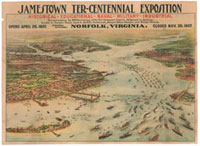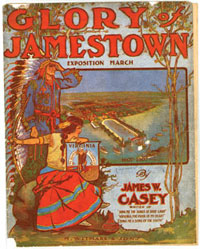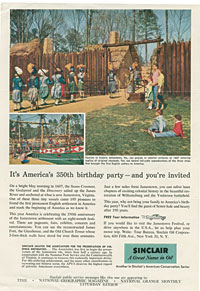Once history happens, it is gone forever. No two witnesses remember or tell exactly the same story about what happened. What is left are the memories of the event, told and retold through generations, with each teller relating what he or she thinks important. This “historical memory” results from collective memory, the writing of history, and the celebration or commemoration of historical events. Public events, such as commemorating the founding of Jamestown, remembering George Washington’s birthday, or celebrating emancipation from slavery, served to remind Virginians and Americans of the role Virginia played in the history of the United States. Controlling public memory involves the power to control public discourse. Myth and Memory: Understanding Four Hundred Years of Virginia History examines how Virginians have remembered their past through public events, through writing about history, and through marking history on the landscape. Because Virginians are peculiarly interested in, and contentious about, their past, their historical memory often results in competing interpretations.
What Does Jamestown Mean?

Celebrations of the founding of Jamestown in 1807 and again in 1857 linked the early settlement to the establishment of democracy on the American continent. On 13 May 1807 a crowd of 1,500 to 3,000 people, by newspaper accounts, some of whom had direct experience with the American Revolution, celebrated the founding of Jamestown at the site with music, the firing of artillery, and a procession of ladies and civic dignitaries. Orations also celebrated the victory of Americans over the tyranny of the British monarchy in 1781 at nearby Yorktown, casting Jamestown as the beginning of what would become a unified nation. At the 1857 commemoration, speakers, including former U.S. president John Tyler, who spoke for two hours, asserted Virginia’s role in the American Revolution even as the debate over slavery became increasingly tense.

The 1907 Jamestown Ter-Centennial Exposition stressed a common national origin as the United States marked its ascendancy as a world power. Originally intended to be lesson in history, the Jamestown Ter-Centennial Exposition quickly developed into a much more complex event. Organized by a federal commission, the exposition demonstrated American industrial and naval power with a massing of ships dubbed the “Great White Fleet.” It also continued the post–Civil War reconciliation between North and South by stressing a common national origin. For the Virginia organizers and participants, the 300th anniversary was an opportunity to reassert the founding story—the establishment of Jamestown in 1607—as the true historical event in the face of rising interest in the Pilgrim story. Significantly, at the insistence of the federal commission, a building was constructed for displays attesting to the contributions of African Americans to the country’s history and development. Overseen by Giles B. Jackson, the Negro Building housed more then 3,000 exhibitions, including dioramas sculpted by Meta Vaux Warwick Fuller that presented a chronology of the black experience in America.

The 350th anniversary resulted in creation of Jamestown Festival Park, operated by the commonwealth. The celebration in 1957 benefited from a new critical and scholarly approach to Jamestown’s history. Extensive excavations, conducted by trained, professional archaeologists, yielded a better understanding of the hardships faced by the colonists. To share the new findings, the Jamestown Festival Commission devoted much of its resources to publishing educational booklets and microfilming important documents in England. Interpretation of the Jamestown story now broadened beyond “the adventure” to include the lifeways—cooking, farming, clothing, and industry—of the village. This enhanced interpretation allowed inclusion of women in the story and encouraged an interest in a more accurate portrayal of the role of Virginia Indians in the establishment of the English colony.

Broadside.
Nevertheless, the Jamestown Festival of 1957 occurred at a time when the United States and the Soviet Union were locked in the Cold War. In addition to military reviews, the interpretation at the re-created fort and the speeches given during the festivities emphasized the individualism of the Jamestown settlers. To demonstrate the close ties between the United States and the United Kingdom, Queen Elizabeth II and her husband, Prince Philip, visited the festival and lent a copy of the Magna Carta for exhibition. Unlike the 1907 celebration, which had included a building dedicated to African Americans, the 1957 festival took place during the turmoil created by the U.S. Supreme Court decision in Brown v. Board of Education, leading organizers to ignore the issues of race and slavery.
Organizers of the 400th anniversary of the founding of Jamestown in 2007 sought to reflect the inclusiveness and decentralization of modern America by inviting Virginia localities to develop programs and events as “2007 communities.” How will historians interpret the 2007 commemorations of the founding of Jamestown? How will you interpret the activities and events? What historian Carl Becker said in 1932 is most appropriate for 2007: “Every person is his or her own historian.”